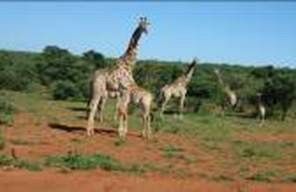The first hurdle nearly became my undoing – Customs are notoriously difficult with film crews but when one of the cases slipped, broke open and bullets spilled on to floor around the custom’s officer’s feet, I knew by his bulging eyes he was about to take an ugly pill and be very, very difficult. After a spluttering that seemed to go on forever, there followed a torrent of Arabic that flowed over me like raging tide. I let him run out of breath before I attempted show him my papers, permissions in both Arabic and English in what seemed to no avail. However, after a time he did calm down and I explained to him, “It is all pre 1915 and the bullets are blanks” – This did not impress him at all but he finally let the rifles and blanks through to my assistant, who moved like lightning to put them on a truck and roared off to our base. If I thought my troubles were over I was wrong. I had hoped he would just read the permissions and let the other boxes through. As I reached to push a large industrial trolley out of the Custom area, he stepped in front and motioned for me to open them. I showed my papers again and he again told me to open crates in what probably was exasperated Arabic. Stalling no longer, he opened the crates. The first one contained Lewis machine guns, belt ammunition, for the use of, etc, he rushed to another opened that and saw explosives of the Special Effects Dept. He threw a major tantrum, shouted, men rushed up and he hadn’t even reached the very large crate that contained the Artillery piece!
About five years ago, just after it became religiously correct to play music and TV was up and running, though mostly programmes showing the Mosque or the Royal household. McMillan Films had taken me from the cold of a London winter to the heat of Saudi Arabia to help in making a Drama Documentary about the ‘Birth of Saudi Arabia’ and ‘King Abdulaziz ibn Saud’ who reigned for over fifty years and was a remarkable brave clever soldier, religious leader and statesman and he was both a good friend of Winston Churchill and President Roosevelt. A remarkable well informed man on world affairs the king had two radio operators, whose job it was to monitor world news and give a summary to him every night of the week. My job as 1st Assistant Director/Production Manager was to help organize and make it all happen – With the help of course, of a Regiment of Cavalry, some of the Camel Corps and two battalions of infantry from the Kingdom.
Thanks to Customs, a little rescheduling was needed. So we started with what we had, rifles and blanks. The king had to clear the bandits off the Caravan Trails and make them safe for trade and this became one of our first scenes.
The hiatus with the Customs’ continued, it was more than their ‘jobs worth’ to let our weapons, props through – So we had to make appointments higher up the food chain, to deal with this problem and as with many things in the Kingdom, this took some time.
In this down time between appointments the Producer, Michael McMillan and I went to see the Camel races – Sand instead of grass track and little boys were the jockeys, other than that it was just like a racecourse in England! We were also invited to a sumptuous lunch at a GPS location in the desert, a three hour drive seeing no one or anything but sand but on arrival we joined a couple of thousand others for sweet tea, on a carpet, by a log fire; hundreds of miles, maybe thousands from the nearest forest. A traditional meal of Mutton, Camel, exotic salads and fruits both to eat and drink; laid out in the tents. Each tent held about four hundred men and of course no women present at all. Cross legged on the carpeted interior, we discussed the Euro and the probability that it would take fifty years for Europe to become a federation! After lunch a strange sort of singing, chant filled the air and the Prince, courtiers started to sway, swords in the air. Suddenly, I was offered a sword, put in the middle and before I could worry if I could do the dance and not slice anyone with my weapon, I was amongst them. The clash of swords, the swaying of bodies to the slow drum beat, the thrusting intrusion of a news camera, this I thought, is what it’s like when you dance with a Prince!
The heat seemed stifling, the sun was trying to bore its way through my Tilley hat, the sweat was sticking to my back, I tried to clear my parched throat; before starting my radio check. The stillness of the desert was only broken by my Walkie Talkie radio, “Turn over sound”, “Sound rolling”, came the reply, “Action Cavalry”, “Turn over cameras, stand by special effects”, I said . The horses appeared, from a walk, gathered pace into a cantor and as they approached the camera and myself the cavalry became a thunderous noise of drumming hooves with dust enveloping both man and beast. Special effects joined in and from what had been a dead silence of a few moments ago was now a cacophony of explosions, ground shaking, men shouting their battle cries, the smell of cordite in the air caching in your throat, your adrenalin pumping as this regiment of horses sweeps by only passing a few feet away. A famous General once said, “The only thing worse than a battle won, is a battle lost”. Our battle with the customs now over we had started to film our horse and camel charges and the reason I had time to take these photos is that these set pieces take time to set up. Like real soldiering: filming is all about ‘hurry up and wait.’ The shot of the single charging warrior, I sometimes put on the front of an envelope that contains my CV – With a balloon coming out of his mouth, the words ”My CV must get thru” in it.
King Abdulaziz was the first person to put machine guns on moving vehicles. Model T Fords had Lewis guns set up on them, so they could be moved about the battlefield. So with his small force but with cannon, machine guns, the latest rifles of the time, he out thought as well as out fought his enemies.
We set up an ambush and made use of our Lewis guns, the ordinary Saudis so peaceful now, we found it most difficult to teach them to pretend to fight but they certainly died well in our ambush! Of course this scene was cut from the film, as they did not want the real story warts and all.
The Cavalry were normally used in demonstrations of horsemanship, in Royal tournaments etc. So they really enjoyed riding the desert and taking part in mock battles and too be very honest I also thought myself privileged to be enjoying all the fun of old style warfare but without the casualties or consequences.
[kml_flashembed movie=”/wp-content/blogs.dir/3/files/pictures/2007/Saudi-Desert-TA.swf” height=”450″ width=”450″ /]
About the author Tony Annis: Have camera will travel. Over the top but not yet over the hill. Past sixty five and still alive, my get up and go has not entirely got up and gone – like good whisky, I’m still going strong. Travelling through these global villages of ours is great adventure but to me it is the people that make this wonderful world, as well as the exotic places that I love to visit. See you over the next horizon, Tony.

 You don’t need to worry about getting your newly acquired purchases home as PNG Arts has a reliable packing, crating and shipping service, which the Beetle has twice used and all items arrived safely in London, taking about three months – see the very exciting picture left.
You don’t need to worry about getting your newly acquired purchases home as PNG Arts has a reliable packing, crating and shipping service, which the Beetle has twice used and all items arrived safely in London, taking about three months – see the very exciting picture left.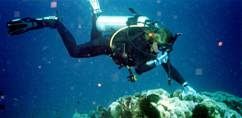 Anyway, down to business, this is not an ad for PNG Art, the Beetle wants to talk about Rabaul. Rabaul is a natural harbour on one of PNG’s islands, this one is New Britain, part of the Bismark Archipelago, which is immediately north of the main part of PNG. Rabaul has a sheltered deep harbour which allows good anchorage for large cargo and cruise ships. The harbour itself is a massive flooded caldera of an ancient volcano – it here that the Beetle did many fantastic dives. See the picture above right of a very undignified Beetle hanging on to some dead coral for dear life as the currents threatened to wash her away.
Anyway, down to business, this is not an ad for PNG Art, the Beetle wants to talk about Rabaul. Rabaul is a natural harbour on one of PNG’s islands, this one is New Britain, part of the Bismark Archipelago, which is immediately north of the main part of PNG. Rabaul has a sheltered deep harbour which allows good anchorage for large cargo and cruise ships. The harbour itself is a massive flooded caldera of an ancient volcano – it here that the Beetle did many fantastic dives. See the picture above right of a very undignified Beetle hanging on to some dead coral for dear life as the currents threatened to wash her away. From 1910 until 1937 Rabaul was under German control and the base of Japanese activities in the South Pacific during World War II and there are many remains and relics to be seen as a result of this and subsequent Japanese occupation.
From 1910 until 1937 Rabaul was under German control and the base of Japanese activities in the South Pacific during World War II and there are many remains and relics to be seen as a result of this and subsequent Japanese occupation. 
 If you have an interest in WW2 artefacts and wish to gain a better understanding of the events in this part of the South Pacific, there is no better place to visit than the Kokopo war museum. It is largely set outdoor amidst beautifully manicured gardens with a gorgeous collection of frangipani ad star fruit trees.
If you have an interest in WW2 artefacts and wish to gain a better understanding of the events in this part of the South Pacific, there is no better place to visit than the Kokopo war museum. It is largely set outdoor amidst beautifully manicured gardens with a gorgeous collection of frangipani ad star fruit trees. 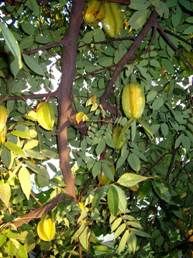
 German colonial period, pre-war and WWII Japanese occupation such as tanks, search lights, munitions, motorcycles, half-tracks, guns, artillery, machine guns, and the wrecks and partial wreck of many Japanese aircraft.
German colonial period, pre-war and WWII Japanese occupation such as tanks, search lights, munitions, motorcycles, half-tracks, guns, artillery, machine guns, and the wrecks and partial wreck of many Japanese aircraft. 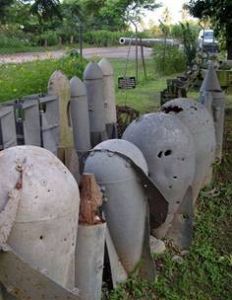
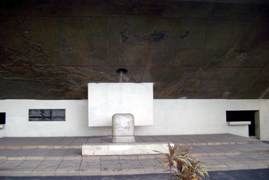 Japanese War Memorial A war memorial was constructed by the Japanese after WWII as a peace memorial, and in memory to those who lost their life in and around Rabaul. It is on a hill above the town, with a fabulous view of
the area that was once occupied by thousands of Japanese Navy and Army personnel. The memorial is not without a little controversy. The huge map of the Pacific with New Britain and Rabaul at the centre forms the background of the memorial also
shows the sites of Jap
anese conquests. This elicited a response from the Australian government that the memorial signified Japanese occupation rather than promote their subsequent peaceful intentions. You can see in the Beetle photo left that there is a hole that lets the sun shine directly onto a simple pillar shrine.
Japanese War Memorial A war memorial was constructed by the Japanese after WWII as a peace memorial, and in memory to those who lost their life in and around Rabaul. It is on a hill above the town, with a fabulous view of
the area that was once occupied by thousands of Japanese Navy and Army personnel. The memorial is not without a little controversy. The huge map of the Pacific with New Britain and Rabaul at the centre forms the background of the memorial also
shows the sites of Jap
anese conquests. This elicited a response from the Australian government that the memorial signified Japanese occupation rather than promote their subsequent peaceful intentions. You can see in the Beetle photo left that there is a hole that lets the sun shine directly onto a simple pillar shrine.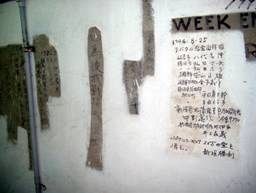
 The Japanese used forced labour to build a series of tunnels through many parts of Rabaul. You can still see these tunnels sixty years later. Some of the tunnels were used to live in, store munitions and guns, and others were used to house barges. The Beetle photo left shows the remains of one such barge. One tunnel in particular is large enough to have stored five landing craft. During the war, these were carefully lifted out of the tunnel using a hoist system, taken across to the cliff face where they were lowered into the water.
The Japanese used forced labour to build a series of tunnels through many parts of Rabaul. You can still see these tunnels sixty years later. Some of the tunnels were used to live in, store munitions and guns, and others were used to house barges. The Beetle photo left shows the remains of one such barge. One tunnel in particular is large enough to have stored five landing craft. During the war, these were carefully lifted out of the tunnel using a hoist system, taken across to the cliff face where they were lowered into the water.  ooks dim. But the story here is Greek Macedonia, one of the most beautiful regions of Greece, and an area which will grow in importance as the commercial and cultural centre of the Balkans in the years to come.
ooks dim. But the story here is Greek Macedonia, one of the most beautiful regions of Greece, and an area which will grow in importance as the commercial and cultural centre of the Balkans in the years to come. 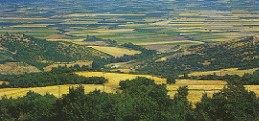 Founded by King Perdikas in the 7th Century BC it was formally known as Aigaes and was the first capital of Macedonia. When the capital was moved to Pella it was continued to be used as the royal burial grounds. In 336 BC, King Phillip II was assassinated by one of his seven bodyguards while attending the wedding of his daughter Cleopatra in the theatre.
Founded by King Perdikas in the 7th Century BC it was formally known as Aigaes and was the first capital of Macedonia. When the capital was moved to Pella it was continued to be used as the royal burial grounds. In 336 BC, King Phillip II was assassinated by one of his seven bodyguards while attending the wedding of his daughter Cleopatra in the theatre.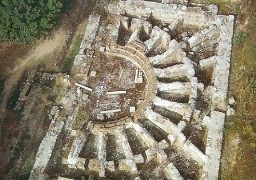 Ancient Dion was an important religious centre for worshipping the Gods of nearby Mount Olympus. This is where Phillip II came to celebrate his victories and his son Alexander came to make his sacrifices here before going off to conquer the East. While most of the statues which were not only found virtually intact, but with traces of colour, are in the nearby museum in the town of Dion, they have been replaced with copies. The Sanctuary of Isis is perhaps the most interesting discovery so far. An earthquake had displaced water and mud and the building was hidden for centuries under 6 feet of water which protected it from vandals. The temple still sits in the water and a copy of the statue of Aphrodite can be seen there.
Ancient Dion was an important religious centre for worshipping the Gods of nearby Mount Olympus. This is where Phillip II came to celebrate his victories and his son Alexander came to make his sacrifices here before going off to conquer the East. While most of the statues which were not only found virtually intact, but with traces of colour, are in the nearby museum in the town of Dion, they have been replaced with copies. The Sanctuary of Isis is perhaps the most interesting discovery so far. An earthquake had displaced water and mud and the building was hidden for centuries under 6 feet of water which protected it from vandals. The temple still sits in the water and a copy of the statue of Aphrodite can be seen there. 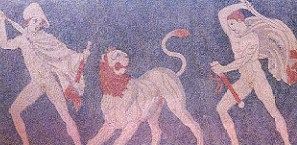 The Capital of Macedonia moved from Vergina to Pella in the 5th Century BC and was in effect the capital of Greece. Many people come here to see the exceptional mosaics discovered in the remains of houses and public buildings. The museum is one of Greece’s best on-site archaeology museums with a display of pottery, jewellery and mosaics found at the site. The remains of the buildings have impressed archaeologists and led them to believe that the Macedonians enjoyed a high level of wealth.
The Capital of Macedonia moved from Vergina to Pella in the 5th Century BC and was in effect the capital of Greece. Many people come here to see the exceptional mosaics discovered in the remains of houses and public buildings. The museum is one of Greece’s best on-site archaeology museums with a display of pottery, jewellery and mosaics found at the site. The remains of the buildings have impressed archaeologists and led them to believe that the Macedonians enjoyed a high level of wealth.  Site of the famous battle where the armies of Mark Anthony and Octavius met and defeated the armies of Julius Caesar’s assassins in 42BC. Brutas and Cassius committed suicide and the victors spent a fortune on Philippi, granting it the status of Roman Colony, providing us with the impressive ruins, and artefacts which are now in the museum. In 49 AD Saint Paul came to preach to the inhabitants of Philippi and ended up in prison. Despite Paul’s misfortune Phillipi was the first European city to accept Christianity, though the first two churches they built suffered some bad luck. The first was destroyed by an earthquake right after it was completed in the 5th century and the second collapsed before its dedication in the 6th Century because it was too top heavy. The remains can both be seen, as well as the ancient theatre built by Phillip II.
Site of the famous battle where the armies of Mark Anthony and Octavius met and defeated the armies of Julius Caesar’s assassins in 42BC. Brutas and Cassius committed suicide and the victors spent a fortune on Philippi, granting it the status of Roman Colony, providing us with the impressive ruins, and artefacts which are now in the museum. In 49 AD Saint Paul came to preach to the inhabitants of Philippi and ended up in prison. Despite Paul’s misfortune Phillipi was the first European city to accept Christianity, though the first two churches they built suffered some bad luck. The first was destroyed by an earthquake right after it was completed in the 5th century and the second collapsed before its dedication in the 6th Century because it was too top heavy. The remains can both be seen, as well as the ancient theatre built by Phillip II. As the name suggests, Daktari is a wildlife orphanage that takes in injured, orphaned, or animals in general that for some reason can not be rehabilitated into the wild. People are educated in animal welfare, the environment and nature conservation by being part of teams which provide the nursing for the animals.
As the name suggests, Daktari is a wildlife orphanage that takes in injured, orphaned, or animals in general that for some reason can not be rehabilitated into the wild. People are educated in animal welfare, the environment and nature conservation by being part of teams which provide the nursing for the animals. Daktari particularly targets underprivileged children from the surrounding rural areas. They are educated in the environment, life skills, and the care of the animals. Sadly, people from the local community suffer from the lack of access to their rich South African natural heritage even though they live right next to private game reserves. This has contributed to the high degree of poaching and environmental abuse in the area. We feel that by generating compassion and understanding, people will care for the environment.
Daktari particularly targets underprivileged children from the surrounding rural areas. They are educated in the environment, life skills, and the care of the animals. Sadly, people from the local community suffer from the lack of access to their rich South African natural heritage even though they live right next to private game reserves. This has contributed to the high degree of poaching and environmental abuse in the area. We feel that by generating compassion and understanding, people will care for the environment.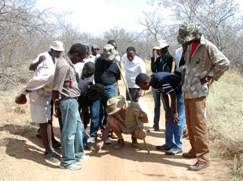 Daktari aims at inviting groups of underprivileged children to stay at the reserve, where they can learn about wildlife, teamwork, responsibility, have a hands-on experience, life skills, and by doing so, develop compassion towards animals. Unfortunately, many children end up unemployed after finishing high School. We expect that the education the children receive here will help them develop their skills and thus provide them with more work opportunities later in life, such as in the eco-tourism industry.
Daktari aims at inviting groups of underprivileged children to stay at the reserve, where they can learn about wildlife, teamwork, responsibility, have a hands-on experience, life skills, and by doing so, develop compassion towards animals. Unfortunately, many children end up unemployed after finishing high School. We expect that the education the children receive here will help them develop their skills and thus provide them with more work opportunities later in life, such as in the eco-tourism industry.